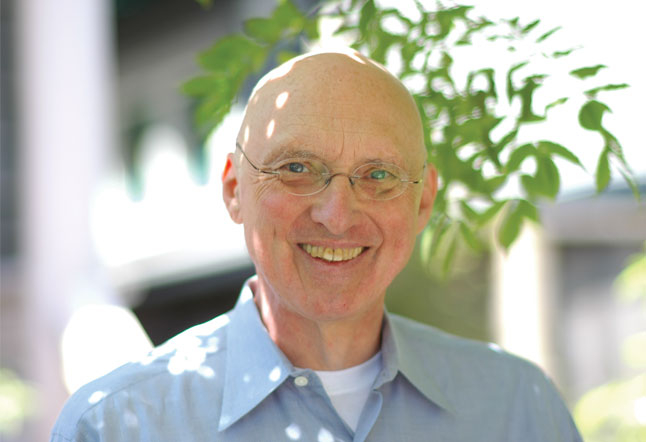donald moyer

Space is sctarce in Donald Moyer’s yoga classes at The Yoga Room in Berkeley – and for good reason. As a long-time teacher, and a teacher of teachers, Donald offers tremendous insight into the asana practice and the art of teaching. To participate in one of his classes is to venture on an exploratory mission with an ever-curious, affable guide.
Donald’s teaching has a freshness, avoiding formulaic approaches. “Iyengar is still my inspiration,” says Donald, although he no longer studies directly with B.K.S Iyengar. “He taught me how to practice, how to experience things for myself and teach from my own experience.”
Donald tries to bring students into a new situation rather repeat a familiar one. “The muscles respond a certain way when they do some thing for the first time. When the action is repeated over and over, it’s a different experience. In my own practice, I try to find my habitual response and try to undo that.”
For students, this freshness and openness invites self-inquiry and discovery during class. Donald’s goal is not so much to get students into a particular alignment, but to get them to feel. “If they’re not able to feel for themselves, they can’t take responsibility: does this feel natural or forced and unnatural? The practice challenges students’ awareness as much as their physical capacities, challenging them to “involve themselves mentally in the physical process.”
Donald cites Mr. Iyengar for developing a practice that fosters union of body and mind, working simultaneously with physical energy and mental energy. Through yoga practice, we can “involve the mind in physical activity…and find some meeting ground between the mind and the body,” he explains. “We also can also become aware of how the mind can affect the body.”
Unlike yoga classes filled with direct instructions about physical movements – step the right foot back, extend the arms overhead, etc. – Donald’s instructions get you into a position (often with props) and then direct your attention to a particular area of the body or aspect of the alignment. The language aims more at your inner experience than your outer body experience. As Donald laughingly admits, “Many instructions can’t be done, at least not directly. It’s internal, allowing.”
This requires an unusual use of language and requires students to pay full attention, read between the lines and follow along as best they can. Most of the students are regulars, and they seem to understand well the way Donald instructs, and perhaps they are accustomed to proceeding into the mystery without a clear map. As one student quietly advised a newcomer, “It works best if I don’t have my mind try to figure it out.”
Donald’s description of Mr. Iyengar’s language – found in Donald’s forthcoming book Yoga: Awakening the Inner Body could apply equally to his own classes: “[Iyengar] spoke to our bodies, not to our brains.”
After more than 30 years, what keeps Donald’s practice fresh? “The practice is a progression, peeling away layer after layer…I’m always finding out new things,” he explains. “Practice is a dialogue – having an intention, expressing that intention, and finding out what the response is…listening to the impulses that come and allowing the body to respond.”
Donald’s approach to sequencing is based on taking a particular insight and exploring that in a variety of different poses. He explains, “You can’t presume that [the experience] is going to be the same in every pose. You have to be alert and see what happens.”
Whatever happens is interesting – or not. Nothing is guaranteed. The practice is about questioning rather than answering. With students practically shoe-horned into the high-ceilinged studio (designed by famed architect Julia Morgan), the level of concentration is high, with a sense of appreciation for subtlety. While students may not be able to explain a particular movement or replicate a particular sequence, they trust and follow Donald down the rabbit hole, again and again.
In his new book, Donald intended to “consolidate what [his] work is…and pass that on.” He continues to teach weekly classes as well as parts of The Yoga Room’s Advanced Studies Program, which he has directed since its inception in 1988.
Unlike many of today’s yoga teachers, Donald is not trying to build a big following or fill large classes. He prefers small classes, rarely travels to host workshops elsewhere and eschews most conferences. While you might say that this makes him inaccessible, he, personally, is anything but that. His warmth and sensitivity, as well as his expertise, sustain a strong community of yoga practitioners. To attend a class, be sure to call or email Donald to see if there is an available space for your mat!
Read next >> Yoga Works Divisadero
Website |
